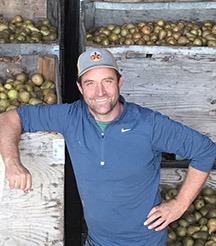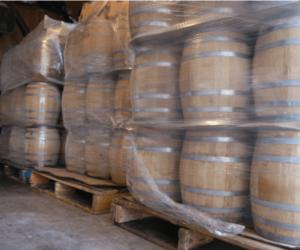Crafting Oak-Aged Cider
Aging hard cider in oak barrels or on oak alternatives adds flavors, aromas, and unique complexities otherwise unobtainable in cider. If that oak previously held another spirit or wine (or was soaked in it, in terms of an oak alternative), the impact these products impart is even greater. Get in on the fun with the advice from two pros with massive barrel programs and years of experience.
Rick Hastings is Founder, Co-Owner, and Head Cidermaker at Liberty Ciderworks in Spokane, Washington.

Before you begin, it’s important to identify what you’re looking to achieve with oak aging. That, plus the characteristics of the cider in question, should guide your decision-making. At Liberty, we barrel-age for three main reasons, often with some overlap:
1) To introduce flavors from used spirit barrels.
2) To introduce oak notes and tannins.
3) To bulk age, allowing the cider to develop and mature with the type of micro-oxygenation afforded by oak barrels.
As a rule of thumb, nearly any type of cider can work when the objective is about marrying flavors — assuming the flavors are complementary, of course. But we generally steer clear of trying to bulk age modern-style ciders in oak, reserving that for ciders featuring our cider-specific varietals. In short, dessert apples are generally best for ciders intended to be packaged and drunk fresh, while ciders with lots of tannic structure are the best candidates for oak aging.
We’ve had great success with wheat whiskey barrels from our local producer, Dry Fly Distillery. These are American oak, with a heavy #3-char. We’ve also had good results with gin and Bourbon barrels from Dry Fly, the former especially with lighter-bodied ciders. For our spirits-influenced products, we usually get just one cycle per barrel. After that, we re-use them as “neutral” barrels for long-term aging.
When seeking fresh oak character we often utilize oak chips instead of new barrels. This provides more control than we’d get otherwise, both in terms of the type of oak and the degree of flavors developed. For such ciders, I’m partial to the vanilla notes typical of French oak. In fact, we use chips for one of our main-line products. When using them, chips are simply measured by weight, packaged loosely in mesh bags, and placed into our bulk aging tanks.
The time we leave the cider in a barrel depends on a few factors. For our whiskey-influenced line, three or four months is usually sufficient. For ciders needing other benefits, i.e., micro-oxygenation and/or malolactic fermentation, figure at least six months, keeping things topped off at all times, of course. Nearly all of our barrels are 55-gallon (200-L), so the timing may be different for smaller barrels homebrewers are more accustomed to.
For us, barrels are best for aging, as we usually try to avoid the mess and hassles of barrel fermentation. Since we generally prefer not to age ciders on gross lees, we prefer to ferment in HDPE or stainless steel, transferring to barrels when we’re ready to age.
Depending on your objectives and type of apples used, give chips or other barrel-alternatives a hard look. The benefits of barrel-aging are often easy to emulate, giving you the chance to experiment and learn before making the heavier investment involved with physical barrels.
Seth Boeve is the Head Cidermaker at Virtue Cider in Fennville, Michigan.

A lot of what you have to consider when deciding whether to oak age a cider or not is dependent on your intent with the cider you’re making and what fruit you’re starting with. Oak adds a lot of depth and complexity to the flavor but also needs to be balanced. Here at Virtue Cider, we oak age almost everything we make but, as I said, that is an expression of our intent with our ciders. For example, with our Brut Cider, a percentage of it is aged in oak to add more complexity to the nice dry Michigan apple cider and help round off some of the intensity.
We predominantly use French oak for aging our Core Series of ciders, all of which previously held wine. A lot of them are Chardonnay barrels, which help balance out some of the higher acids you get from the fruit. Based on our experiences, we get more vanilla-type characteristics in the French oak, although we have also used some American oak Bourbon-aged barrels for some of our ciders, like The Mitten (which is a blend of last season’s pressed apples, aged in Bourbon barrels for up to one year, then backsweetened with this year’s fresh pressed apple juice).
We keep our French oak barrels for as long as we can. We even have some from when we opened the cider house eight years ago. New barrels have more aggressive oak character to add to the cider, but with older barrels they help in other ways as they soften. With spirit barrels we only use them to age once or twice. You really get the character of the spirit with first use and then the character of the barrel in the second use. Then we can blend from there to find the right balance.
How long to age cider in a barrel is dependent on the size of the barrel and the amount of influence you want. You’ll get more character and exposure on smaller barrels, which can also make the process go faster. Here at Virtue, we usually leave them for three months to a year.
We have not released any ciders at Virtue using oak alternatives yet, but we have done research into these products, and see a lot of potential. There are tons of oak alternatives that give lots of good oak character. My biggest suggestion for homebrewers would be to do your research and talk to your homebrew shop or oak alternative vendor.
We predominantly conduct our aging post-fermentation. We choose that route due to the consistency in results. You know what you have going in and you have a pretty good idea of what will then come out of the barrel at the end. Fermenting in the barrel is an option, but it is less predictable since the barrel itself is its own environment. However, fermenting in the barrel definitely can have its own upsides too as it does add more depth to cider. We’ll probably try out more in the future, but it takes you along for a bit more of an unexpected ride.
Oak aging is one of the most exciting aspects of the cider we make here. Some of the best ciders we make come out of oak as it complements the fruit so well. It’s a little more effort, risk, and requires a little more education on the cidermaker’s part, but I think it is totally worth it! I’d definitely recommend trying it out for yourself!



